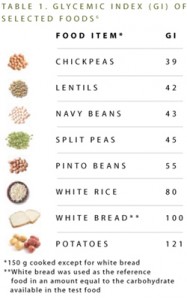 The Glycemic index was developed as a means of ranking carbohydrates (or carb-containing foods) based on their effect on blood sugar level. Foods with a high glycemic index value tend to raise blood sugar levels faster and higher compared to foods with a lower glycemic index. Rapid increases in blood glucose are potent signals to the beta-cells of the pancreas to increase insulin secretion. Over the next few hours, the high insulin levels induced by consumption of high-glycemic index foods may cause a sharp decrease in blood glucose levels (hypoglycemia).
The Glycemic index was developed as a means of ranking carbohydrates (or carb-containing foods) based on their effect on blood sugar level. Foods with a high glycemic index value tend to raise blood sugar levels faster and higher compared to foods with a lower glycemic index. Rapid increases in blood glucose are potent signals to the beta-cells of the pancreas to increase insulin secretion. Over the next few hours, the high insulin levels induced by consumption of high-glycemic index foods may cause a sharp decrease in blood glucose levels (hypoglycemia).
In contrast, the consumption of low-glycemic index foods results in lower, but more sustained, increases in blood glucose and lower insulin demands on pancreatic beta-cells. However, this does not necessarily mean that a low-index food is healthier than a high-index food.
 How the Glycemic Index was Developed
How the Glycemic Index was Developed
To determine the glycemic index of a food:
- Volunteers were/are given a test food that provides 50 grams of carbohydrate one day and a control food (white bread or pure glucose) that provides the same amount of carbohydrate on a different day.
- Blood samples are taken prior to eating and at regular intervals after eating over the next several hours.
- The changes in blood sugar/glycemic response is calculated and multiplied by 100 to give a percentage.
- For example, a baked potato has a glycemic index of 76 relative to glucose and 108 relative to white bread. Meaning the blood glucose response to the carbs in a baked potato is 76 percent of the blood glucose response to the same amount of carbs in pure glucose and 108 percent of the blood glucose response to the same amount of carbs in white bread.
- In contrast, cooked brown rice has a glycemic index of 55 relative to glucose and 79 relative to white bread.
(Confusing, I know, but I wanted you to see a little behind how these values are found and therefore how the food is ranked.)
Although this glycemic index does provide us with a benefit of potentially helping lowering an individual’s blood sugar levels, it is very complicated because many factors affect the glycemic value of a specific food (i.e. how it’s prepared, what’s eaten with it, and some foods are unable to establish a glycemic value). For these reasons, the American Diabetes Association has concluded there isn’t enough evidence to recommend the general use of a low glycemic index diet for people with diabetes and there is much controversy as using it as a tool for losing weight.
If you’re interested in learning more about this meal-planning tool, talk to a registered dietitian. She/he can help you make changes in your diet.) The best advice I can give when dealing with carbohydrates, is try to consume mostly whole-grain, whole-wheat options, choose healthy fruits and veggies, and try to eat carbs and protein together to help with blood sugar maintenance.
Learn more in “What Everyone Needs to Know About Carbs.”

There are some wonderful diet guidelines and great recipes for diabetics at . They list carb amount, calories, fat, fiber content, Glycemic Index (GI), Glyco Load (GL). I haven’t seen any other sites that offer the GI and GL together in their recipes. Good site if you’re looking for new ideas and good info.